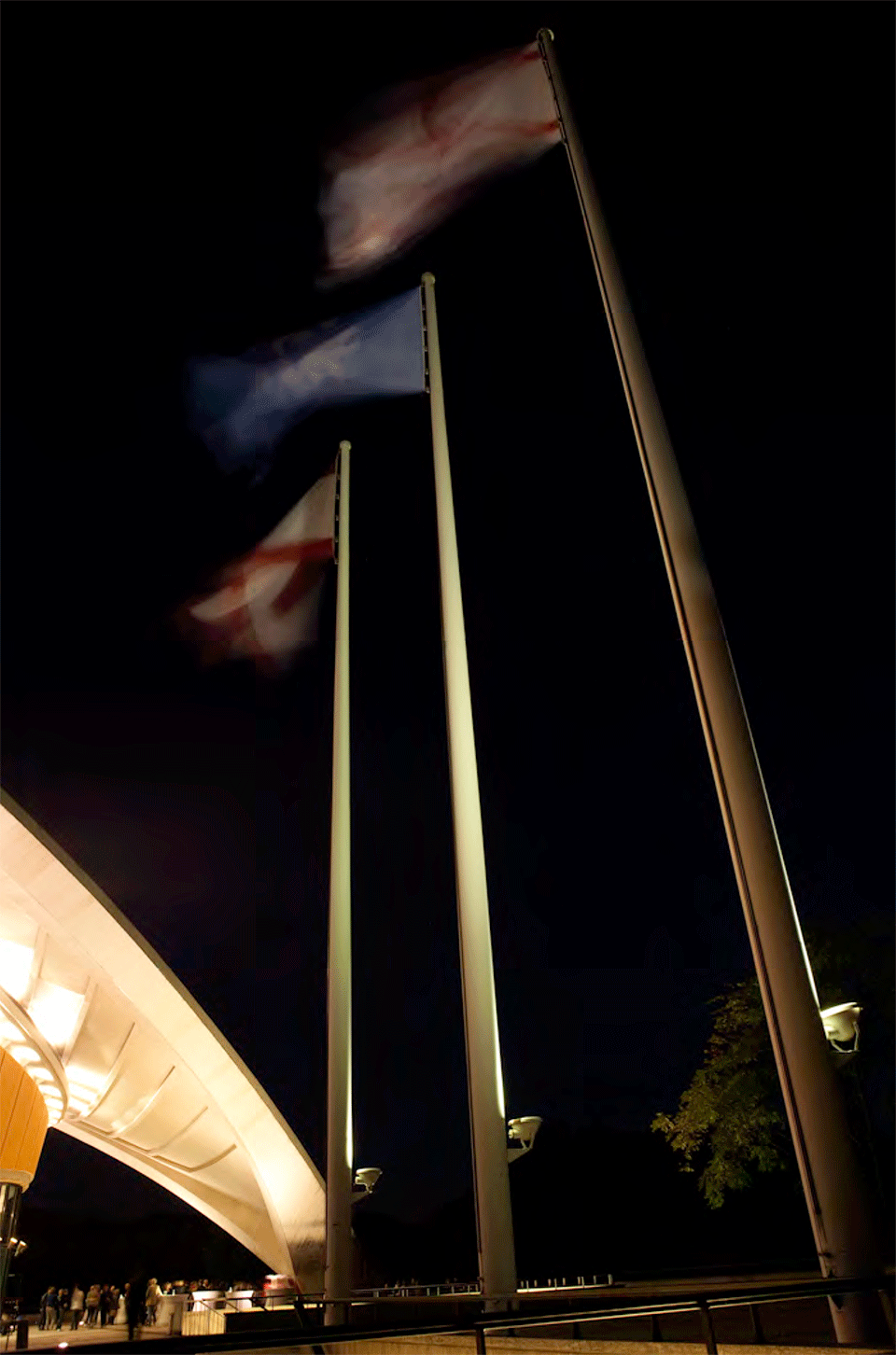- Typology
- Exhibition
- Project
- Doppeltes Berlin @ Between Walls and Windows XXX
- Partner
Initiative Weltkulturerbe Doppeltes Berlin (Arno Brandlhuber, Tobias Hönig & Christian Posthofen)
- Client
in the exhibition "Between Walls and Windows"
- year
- 2012
- Location
- Haus der Kulturen der Welt (HKW), Bezirk Mitte, Berlin, Deutschland
- curation
- Valerie Smith
- with contributions by
- Amateur Architecture Studio (Wang Shu & Lu Wenyu), Ângela Ferreira, Terence Gower, Iñigo Manglano-Ovalle, Marko Sančanin (Platforma 9,81), Eran Schaerf, Studio Miessen, Supersudaca
- films on the doubled berlin
- Institut für Zeitbasierte Medien und der Experimentellen Filmgestaltung der UdK Berlin (Prof. Heinz Emigholz & Michael Busch): Laslo Antal, Nike Arnold, Juana Awad, Anne Behrndt, Julian Brinkmann, Mathieu Brohan, Guillaume Cailleau und Hanna Slak, Emily Keslar, Antonia Kilian, Kornelia Kugler und Lena Siebertz, Sungeun Kim, Yair Glotman, Nadja Krüger & Elisa Storelli, Vincent Maigler, Alicja Sowiar, Björn Speidel
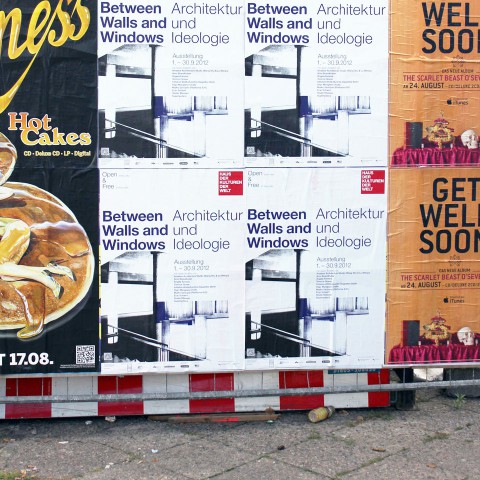 XXX
XXX
Fig.001The exhibition poster in the run-up to "Between Walls and Windows" somewhere in Berlin...
© Lara Hies
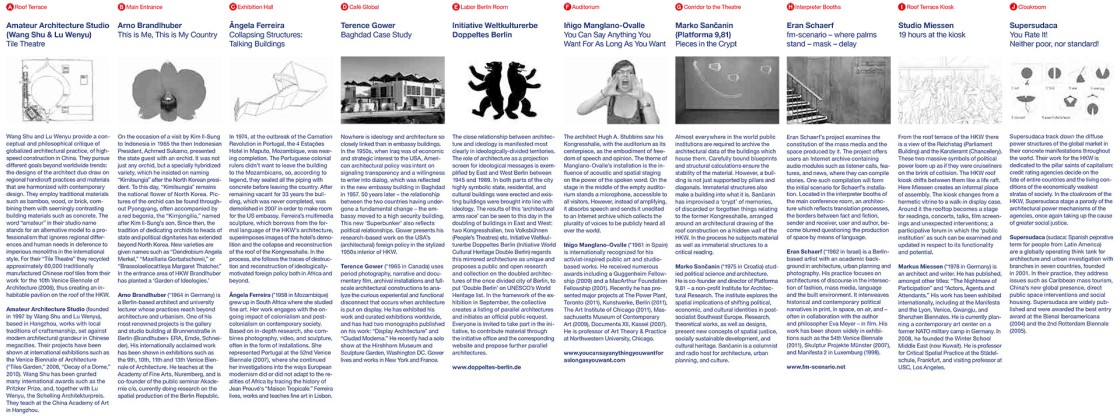 XXX
XXX
Fig.045Between Walls and Windows. Architektur und Ideologie
2012, Sep 01, Sat — 2012, Sep 30, Sun
Only in September, as part of the exhibition Between Walls and Windows. Architecture and Ideology, curated by Valerie Smith, can this architectural landmark be experienced anew as a large-scale sculpture, reinterpreted through artistic and architectural interventions that lay bare the ideological agenda of post-war modernity. With free admission and access from north, south, east or west, the exhibition promises new insights and perspectives on form, function and history.
The architecture of the former congress hall and the history behind it form the focal point of Between Walls and Windows. Architecture and Ideology. The artistic approach is focused not on the building itself but on the ideas and questions which architecture answers, as an instrument of construction history, philosophy and politics.
The project presents ten location-specific new productions by international artists and architects, who will transform the interior spaces and exterior surfaces of Haus der Kulturen der Welt, facilitating a discussion of all the things “architecture“ can be. The exhibition places the local history of the former congress hall in a new, contemporary and global context and casts a spotlight on the Haus der Kulturen der Welt as a sculpture.
A catalog with numerous texts and a comprehensive photo section is being published by the Hatje Cantz Verlag to mark the exhibition opening on 1 September.
With new works by:
Studio Miessen, Supersudaca, Amateur Architecture Studio (Wang Shu & Lu Wenyu), Arno Brandlhuber, Ângela Ferreira, Terence Gower, Initiative Weltkulturerbe Doppeltes Berlin (Arno Brandlhuber, Tobias Hönig, Christian Posthofen), Iñigo Manglano-Ovalle, Marko Sancanin (Platforma 9,81), Eran Schaerf, Studio Miessen, Supersudaca, and others.
© Haus der Kulturen der Welt (HKW)
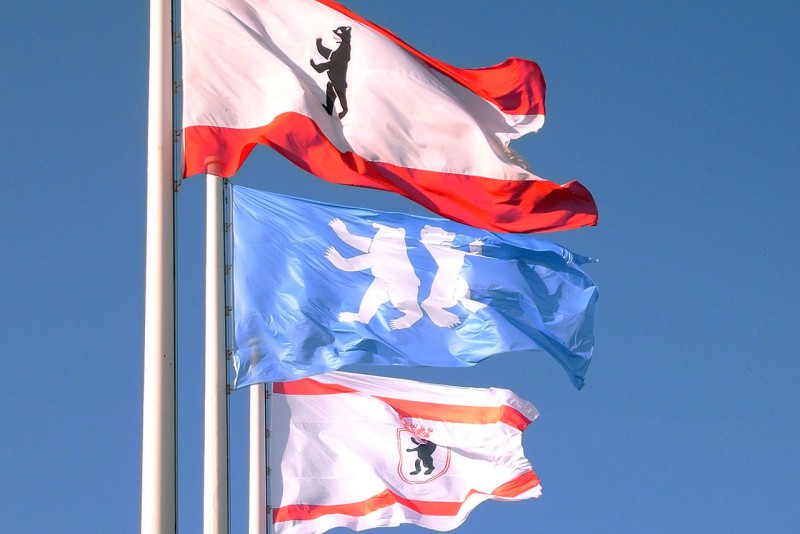 XXX
XXX
Fig.003© Alexander Koch, KOW Berlin
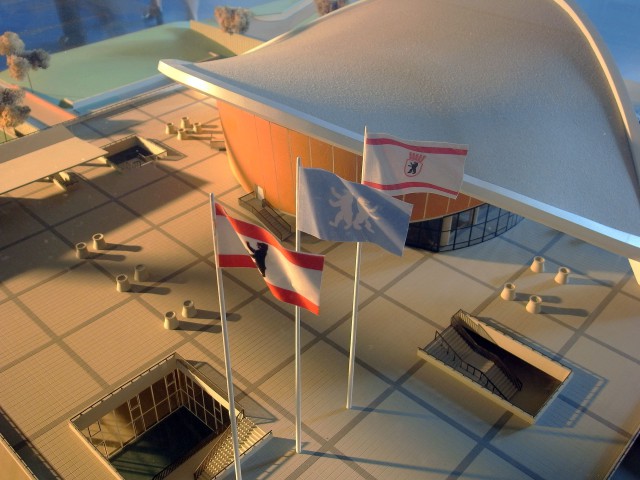 XXX
XXX
Fig.020© Alexander Koch, KOW Berlin
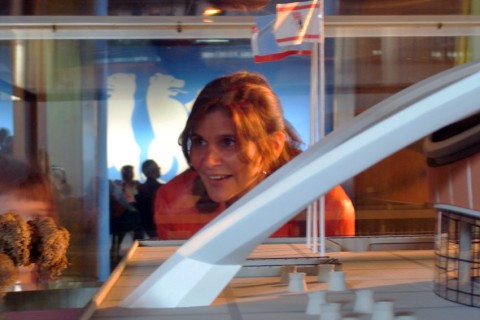 XXX
XXX
Fig.021© Alexander Koch, KOW Berlin
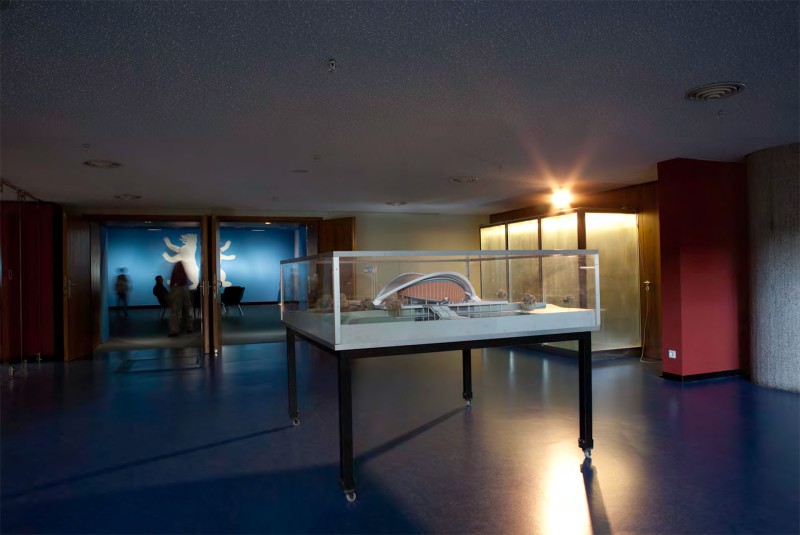 XXX
XXX
Fig.042© Judith Affolter & Thomas Eugster
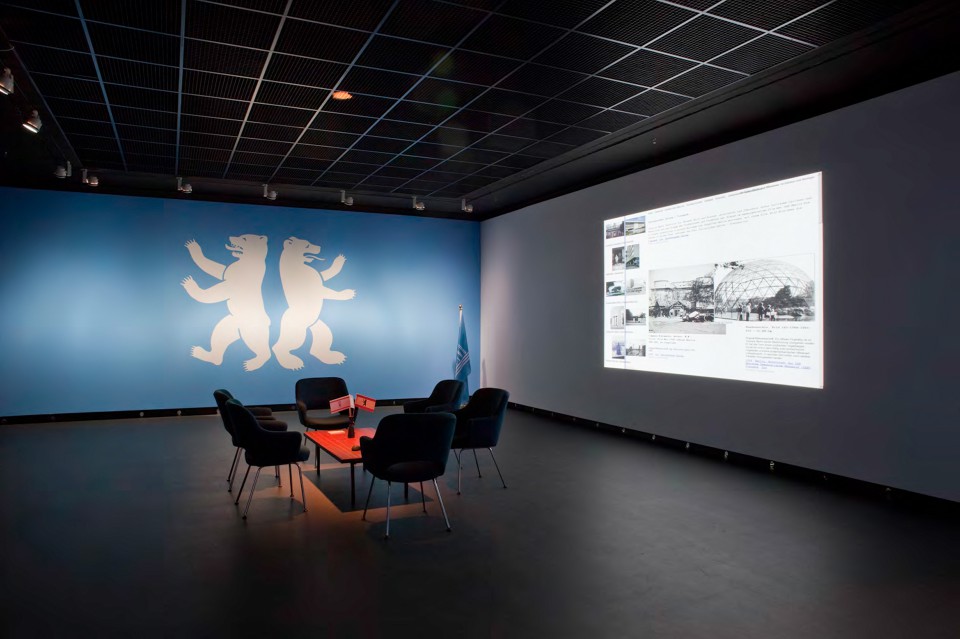 XXX
XXX
Fig.002V(v)V
© Judith Affolter & Thomas Eugster
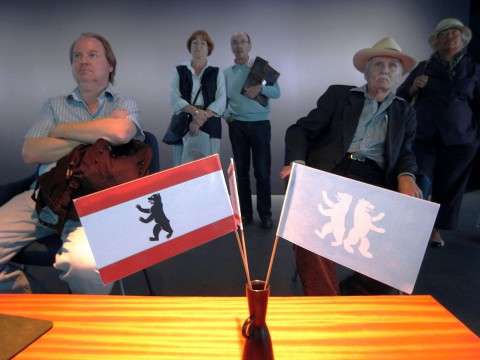 XXX
XXX
Fig.019© Alexander Koch, KOW Berlin
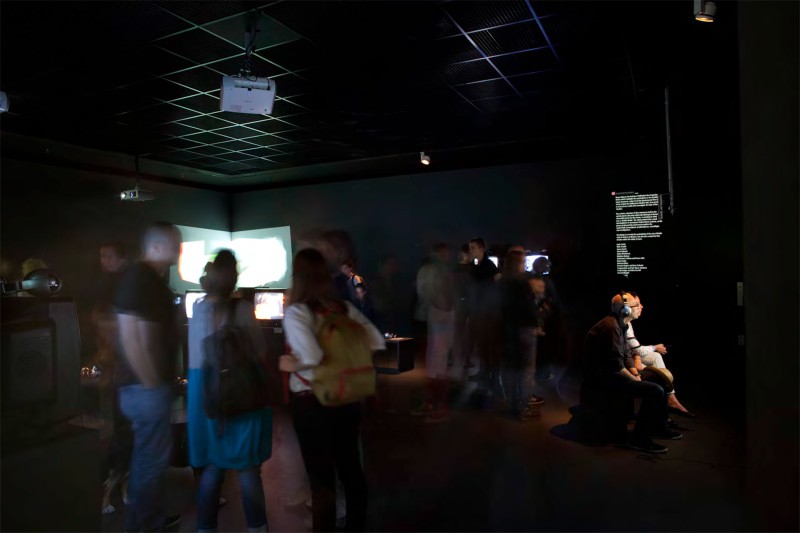 XXX
XXX
Fig.005Films by the UDK referring to the 'Doppeltes Berlin'
1.9. - 11.11. daily 10 - 19 h
Filmmakers and media artists from theInstitut für Zeitbasierte Medien und der Experimentellen Filmgestaltung der UdK Berlin (Institute for Time-Based Media and Experimental Film at the University of Arts in Berlin) present their own cinematic positions, which they have developed specially for the occasion. Based on the terms “East” and “West”, they explore, stage and reconstruct the architecture of the dual Berlin and its ways of relating. The results are observations on the contemporary and the historic, interior and exterior, words and gestures, pairings, ruptures and gaps.
With films by Laslo Antal, Nike Arnold, Juana Awad, Anne Behrndt, Julian Brinkmann, Mathieu Brohan, Guillaume Cailleau und Hanna Slak, Emily Keslar, Antonia Kilian, Kornelia Kugler und Lena Siebertz, Sungeun Kim, Yair Glotman, Nadja Krüger und Elisa Storelli, Vincent Maigler, Alicja Sowiar, Björn Speidel
© Judith Affolter & Thomas Eugster
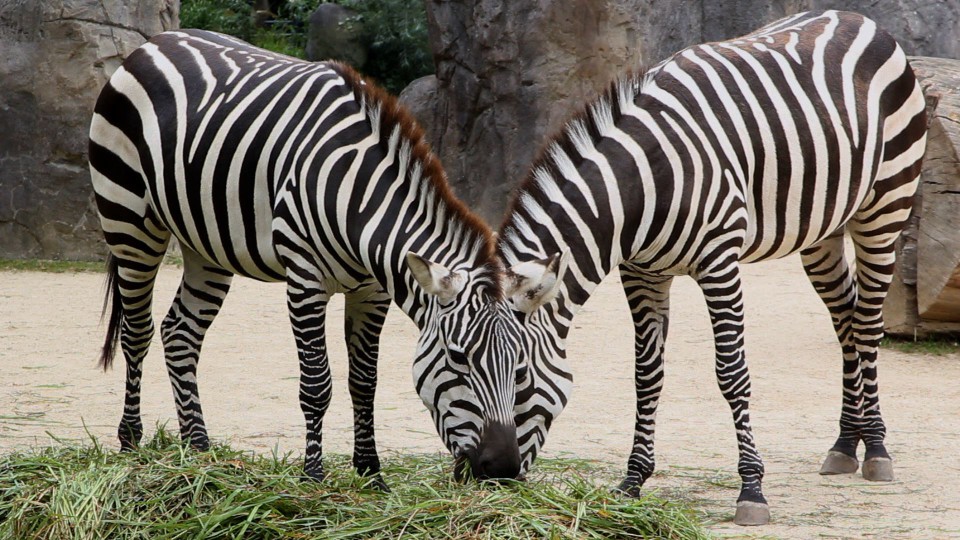 XXX
XXX
Fig.006Still from "Wild Wild", directed by Guillaume Cailleau und Hanna Slak, 12 min
A West-Berlin-Zebra. A East-Berlin-Zebra. Both look towards the city. A Zebra is a Zebra. Animals from both Berlin-Zoos: Tierpark and Zoologischer Garten. The same animals in eastern and western living environments.
© Guillaume Cailleau und Hanna Slak
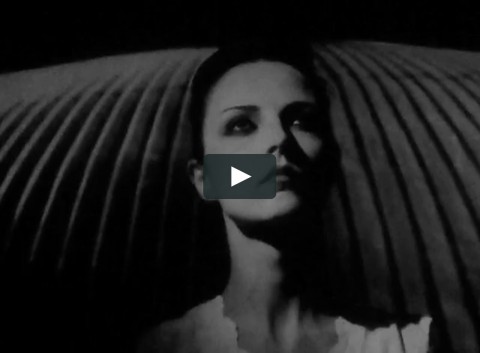 XXX
XXX
Fig.008Still from "One", directed by Laslo Antal, 5 min
The movements of a young woman in front of the Haus der Kulturen der Welt adopt the shape of the congress hall and create space.
© Laszlo Antal
 XXX
XXX
Fig.046Still from "Spiegelpalast", directed by Björn Speidel, 16 min
Footage of the International Congress Center and the Palace of the Republic (or what is left of it) gets weaved together in a stereoscopic pictorial space. The resulting surfaces and spatial elements are able to form new constellations in this sterescopic pictorial space. It arises: a mirror cabinet.
© Björn Speidel
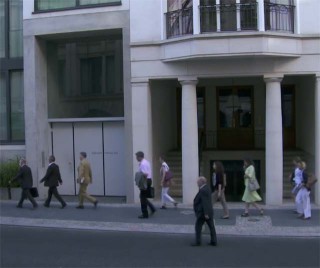 XXX
XXX
Fig.048Still from "Property", directed by Julian Brinkmann, 10 min
Film as reflection on a location. Interest in location, surface, movement of people and then questions: what's between or comes afterwars the doubling? Is there such thing as a ideal state in the relationship of progress and retrospectivity? Or does architecture - set as hard materiality - by its origin oppose a process of equation?
© Julian Brinkmann
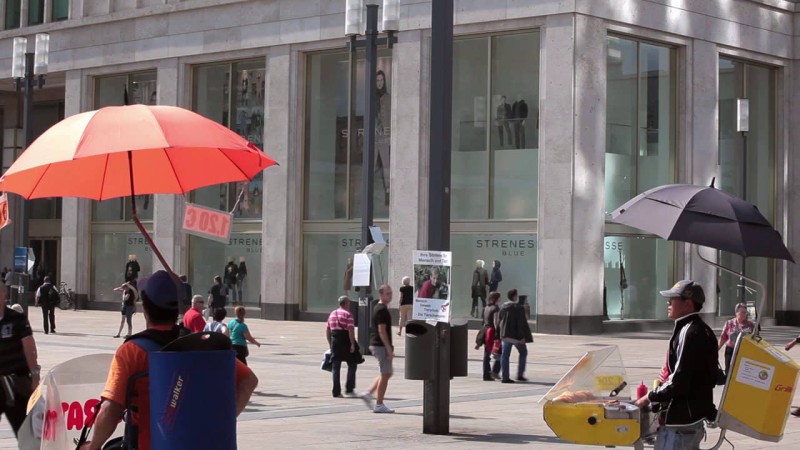 XXX
XXX
Fig.047Still from "Alexanderplatz" directed by Nadja Krüger & Elisa Storelli, 10 min
Names like congress hall, Centrum-store or Hous of Travelling had to give way. But Alexanderplatz cannot be thought without this buildings that are manifests of the former East-Berlin capital center. The video work "Alexanderplatz" is a contemporary portrait of this historical Berlin square - and of the people who explore, use and play on it day by day.
© Nadja Krüger & Elisa Storelli
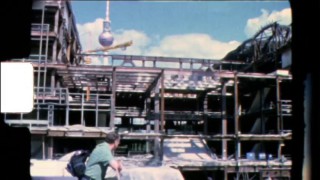 XXX
XXX
Fig.010Still from"P.R." directed by Mathieu Brohan, 43 min
"P.R." is a large scale public relations effort for the recently straightened out Palace of the Republic. In his stead we find a big hole now. From this hole we rebuild the palace, this film reverses time.
© Mathieu Brohan
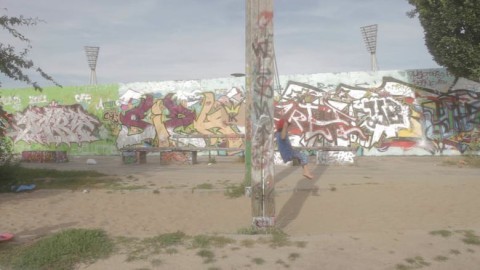 XXX
XXX
Fig.011Still from "Die Grenze", directed by Emily Keslar, 6.44 min
The concept of a "dividing line" is reflected here by grafiti following the Berlin Wall. On both sides exist complementary images, mirror images: heaven, earth, up and down, from behind forward, the idea of "you" and "me".
© Emily Keslar
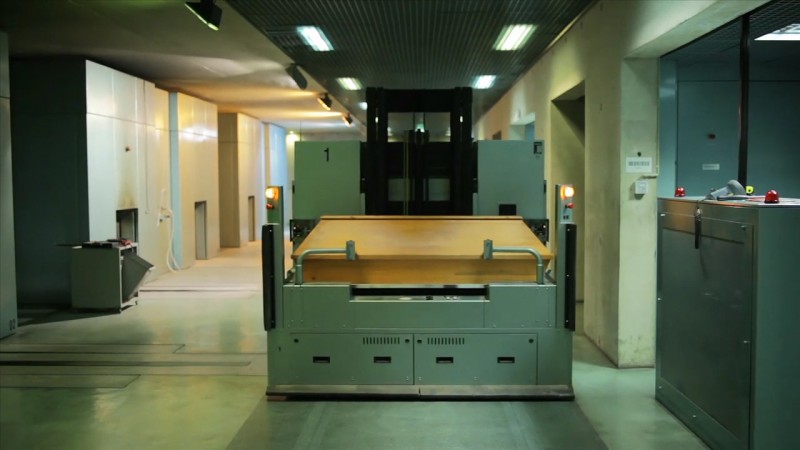 XXX
XXX
Fig.012Still from "Hades Treptow", directed by Nike Arnold, 10 min
The crematory at Berlin-Baumschulenweg is divided in two parts. Upstairs a light sacral room where memorial services are held, downstairs is where the cremation takes place. Robotic machines with long gripper arms take care of the extermination of dead bodies, so that there has to be no human contact with the dead. Which spatial and technical tools construct this distance to death and transience and what stagings are set for this by society?
© Nike Arnold
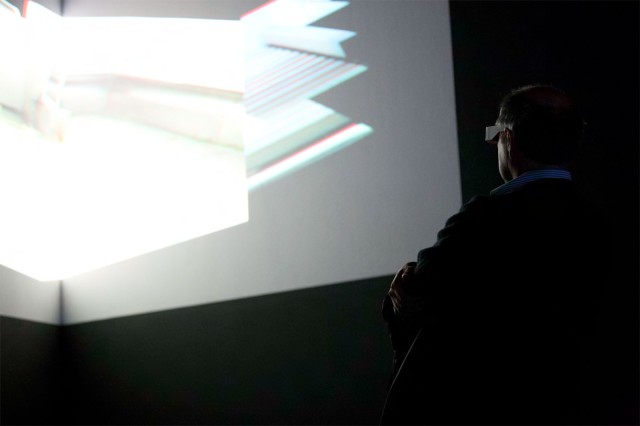 XXX
XXX
Fig.007"Mi tío abuelo estuvo aquí antes (My great-uncle was here before me)" Regie: Juana Awad, 18 min
Der Großonkel der Regisseurin arbeitete mit beim “Aufbau des Doppelten Berlin” – sowohl im westlichen Marshall-Plan als auch im östlichen „Arbeiter- und Bauernstaat“. Seine Erzählstimme schafft den Rahmen für die experimentellen Verbindungen zwischen südamerikanischen und europäischen Utopien, mit der die Regisseurin – vielleicht – ihren Platz im Dazwischen bestimmen kann.
///
"You can see the Nordsee, the North Sea" Regie: Anne Behrndt, 4 min
Es geht um die oft so skurrile Mischung aus Geschichte, Attraktion, Tourismus und Alltag. Architektur als vorbeiziehende Fassade oder unterhaltsamer Hintergrund.
///
"ABRISS - Panoramablick und Geschichtsmontagen" Regie: Kornelia Kugler und Lena Siebertz, 5 min
Eine Text-Bildmontage, die sich durch die (post-)koloniale und (post-)sozialistische Geschichte der Berliner Mitte bewegt.Einzelne Fragmente werden aufgelesen und in Beziehung gesetzt, um ideologische Konstruktionen, wie die Dichotomie "klassizistisch - modern", zu durchqueren. Die Aussichtsplattform der Humboldtbox ist sowohl Ausgangspunkt der fotografischen Blickachsen, als auch der inhaltlichen Reflexion über das Panorama als imperialen Standpunkt.
///
"Music Language" Regie: Sungeun Kim, Yair Glotman, 10 min
Zwei unterschiedliche Musikhochschulen in Berlin: UdK und Hans Eisler. Beide, repräsentierten die jeweilige, westliche oder östliche Form der deutschen Msuikerziehung. Der Film abstrahiert von den visuellen Charakteristika der Hochschulen hin zu einer Reflexion der Rolle der Töne, um einen Raum zu definieren.
///
"Jungbrunnen" Regie: Vincent Maigler, 8.40 min
Der Brunnen als städtischer Ort, als Wasser und Lebensspender, ehemals Treffpunkt der Wäscherinnen, Veranstaltungsort für Feste der Bürgerschaft, seit der Renaissance prunkvolles Machtsymbol der Stadtobrigkeit und heute noch historischer Anziehungspunkt und Sehenswürdigkeit im öffentlichen Raum: ein Porträt über den „Weltkugelbrunnen“ am Breitscheidplatz und den „Brunnen der Völkerfreundschaft“ am Alexanderplatz und ihren Umgebungen.
///
"Guten Tags" Regie: Alicja Sowiar, 25 min
Erst spät entwickelte sich eine alphabetische Schrift, die mit vergleichbar wenigen abstrakten Zeichen arbeitet und jedem Wort eine präzise Struktur aus Konsonanten und Vokalen verleiht. Berlin ist bedeckt mit einer bunten Schicht versprühter Farbe, die in seine Mauern und Wände eindringt. Schriftbilder bei jedem Schritt. Sie verschmilzt das Wort und das Wortbild von Neuem und steht so repräsentativ für die gegenwärtig vielschichtige und sinnliche Kommunikation durch Sprache.
© Judith Affolter & Thomas Eugster
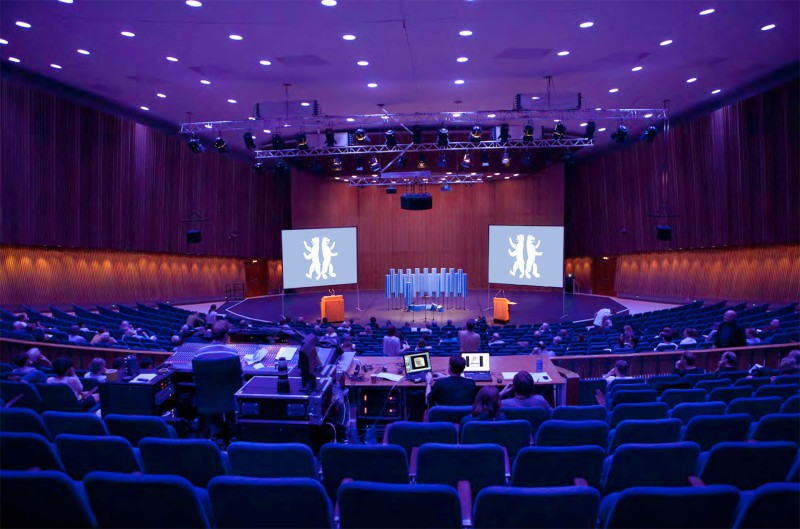 XXX
XXX
Fig.013Setting of the congress "Weltkulturerbe Doppeltes Berlin"
© Judith Affolter & Thomas Eugster
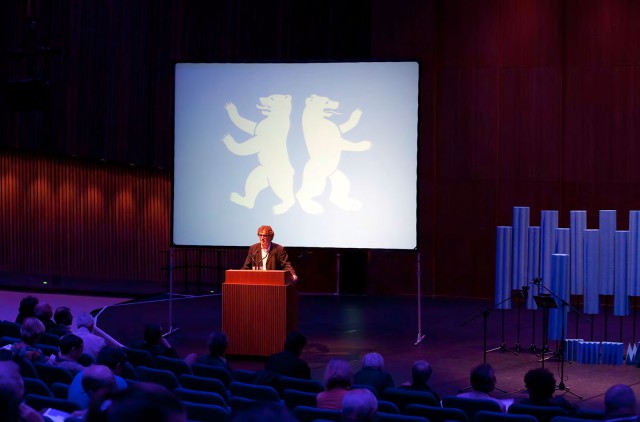 XXX
XXX
Fig.016Welcome: Bernd M. Scherer, Director Haus der Kulturen der Welt
© Judith Affolter & Thomas Eugster
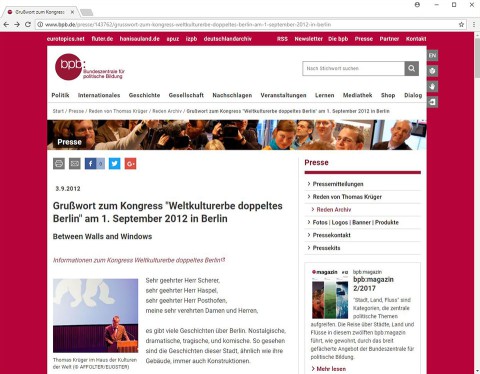 XXX
XXX
Fig.015Welcoming speech Thomas Krüger, president Bundeszentrale für politische Bildung. In January 1991 he was the last (provisional) mayor of East Berlin.
© Bundeszentrale für politische Bildung
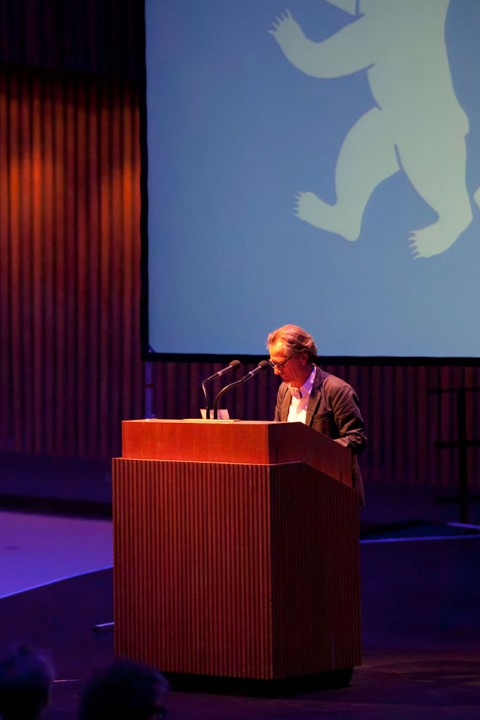 XXX
XXX
Fig.017Welcoming speech "Zur vorstellungsorientierenden Rolle von Architektur" Christian Posthofen (Initiative Weltkulturerbe Doppeltes Berlin)
© Judith Affolter & Thomas Eugster
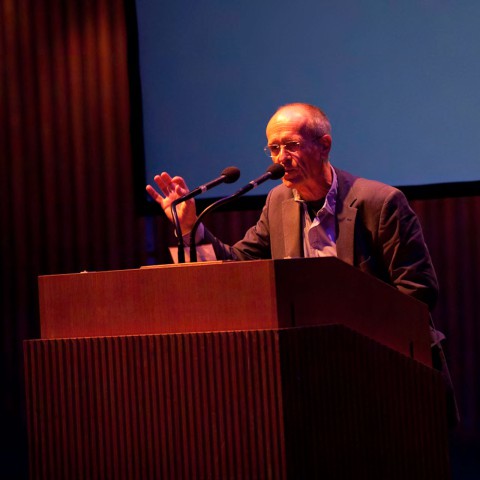 XXX
XXX
Fig.018Lecture „Zu materiellem und immateriellem Weltkulturerbe“ Jörg Haspel, Landeskonservator Berlin / Vice president ICOMOS Deutschland
© Judith Affolter & Thomas Eugster
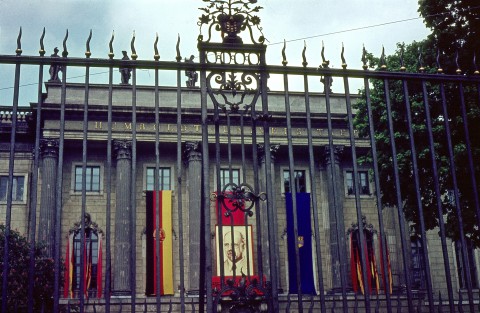 XXX
XXX
Fig.023The Humboldt Universitaet building at Unter den Linden, Berlin in 1964
By Arnoldius (own photo - colorslide scan) [CC BY-SA 3.0 (https://creativecommons.org/licenses/by-sa/3.0)], via Wikimedia Commons
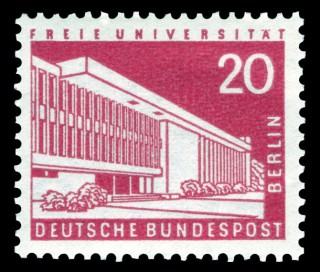 XXX
XXX
Fig.024Definitive stamp series Pictures of Berlin (II)
By scanned by NobbiP (scanned by NobbiP) [Public domain], via Wikimedia Commons
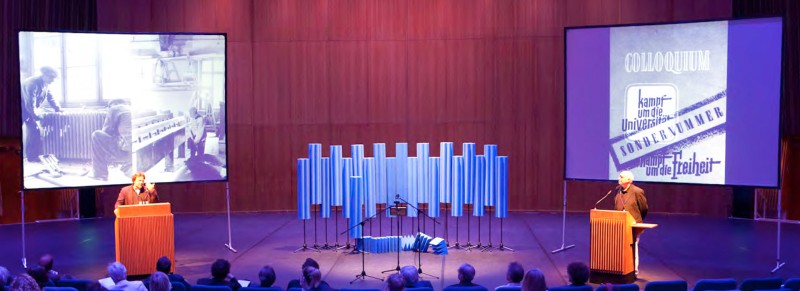 XXX
XXX
Fig.022Humboldt Universität - Freie Universität
Carlo Jordan (ASTAK Forschungs- und Gedenkstätte Berlin-Normannenstraße)
Reinhard Ost (Universitätsarchiv der FU Berlin)
© Judith Affolter & Thomas Eugster
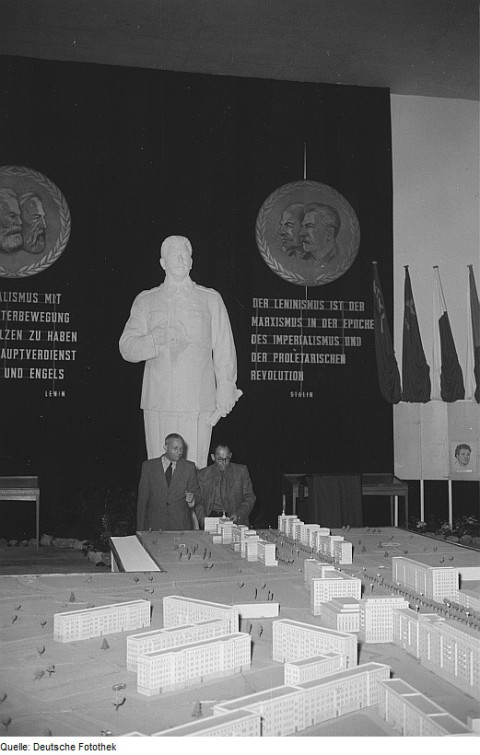 XXX
XXX
Fig.026Model of Stalinallee 1953
Deutsche Fotothek [CC BY-SA 3.0 de]
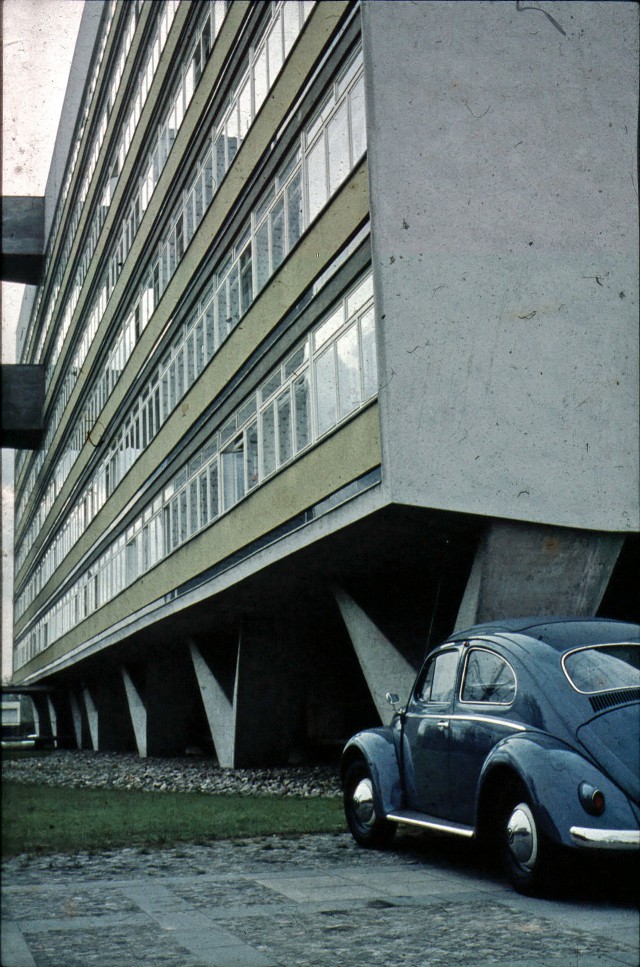 XXX
XXX
Fig.027Oscar Niemeyer, Hansaviertel, 1957
By Kurt Weinland [CC BY-SA 3.0 (https://creativecommons.org/licenses/by-sa/3.0)], from Wikimedia Commons
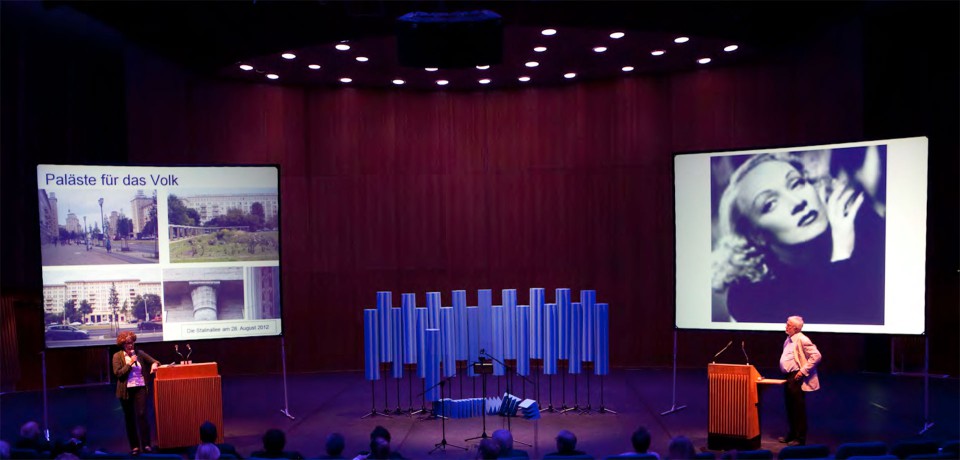 XXX
XXX
Fig.025Stalinallee - Hansaviertel
Gabi Dolff-Bonekämper (Professorin des Gebiets Denkmalpflege an der TU Berlin)
Thilo Geisler (Vorsitzender Bürgerverein Hansaviertel)
© Judith Affolter & Thomas Eugster
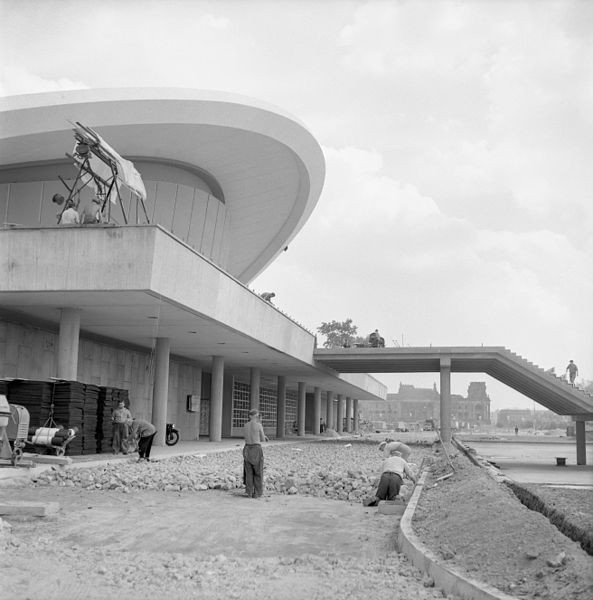 XXX
XXX
Fig.029Construction works at Kongresshalle, Berlin, 1957
By Manfred Niermann (own archive) [CC BY-SA 4.0 (https://creativecommons.org/licenses/by-sa/4.0)], via Wikimedia Commons
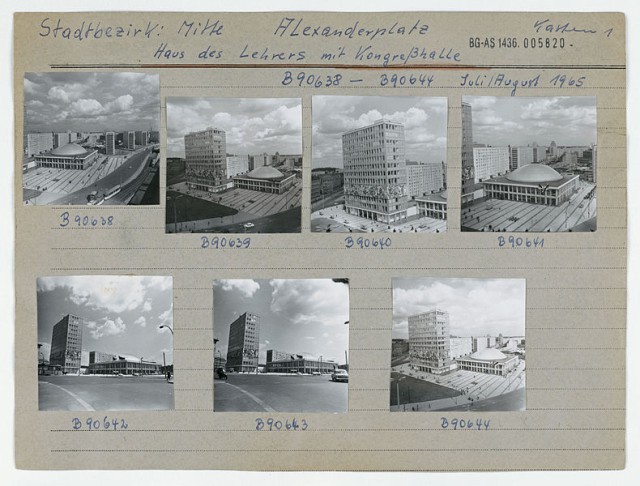 XXX
XXX
Fig.030Ostberliner Fotoarchiv - Berlinische Galerie, Urheberin: Gisela Dutschmann
By Open Knowledge Foundation Deutschland [CC BY 2.0]
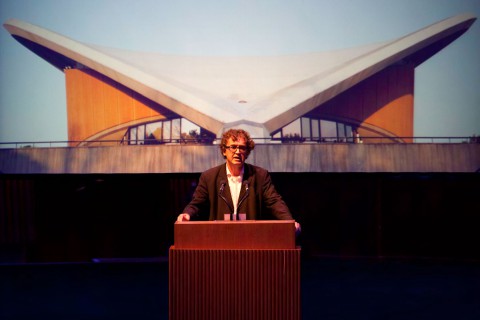 XXX
XXX
Fig.028Kongresshalle West - ...
Bernd M. Scherer (Intendant Haus der Kulturen der Welt)
© Judith Affolter & Thomas Eugster
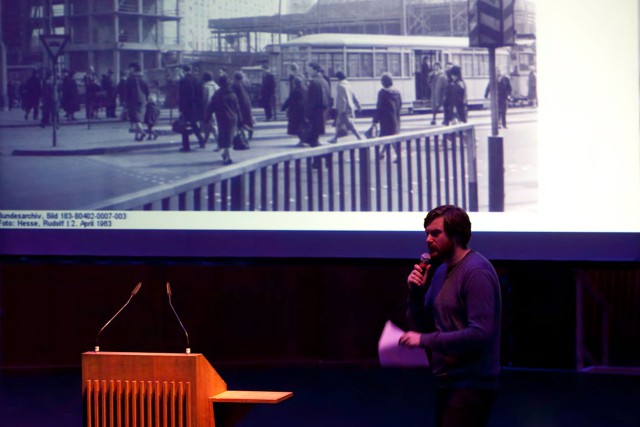 XXX
XXX
Fig.014... Kongresshalle Ost
Tobias Hönig (Initiative Weltkulturerbe Doppeltes Berlin)
© Judith Affolter & Thomas Eugster
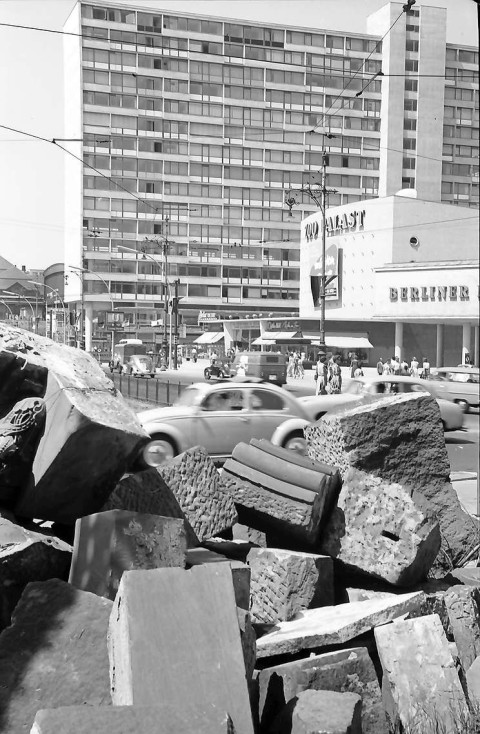 XXX
XXX
Fig.032Rubble of Kaiser-Wilhelm-Gedächtniskirche at Breitscheidplatz in Berlin-Charlottenburg, 1957
Willy Pragher [CC BY 3.0 (https://creativecommons.org/licenses/by/3.0)], via Wikimedia Commons
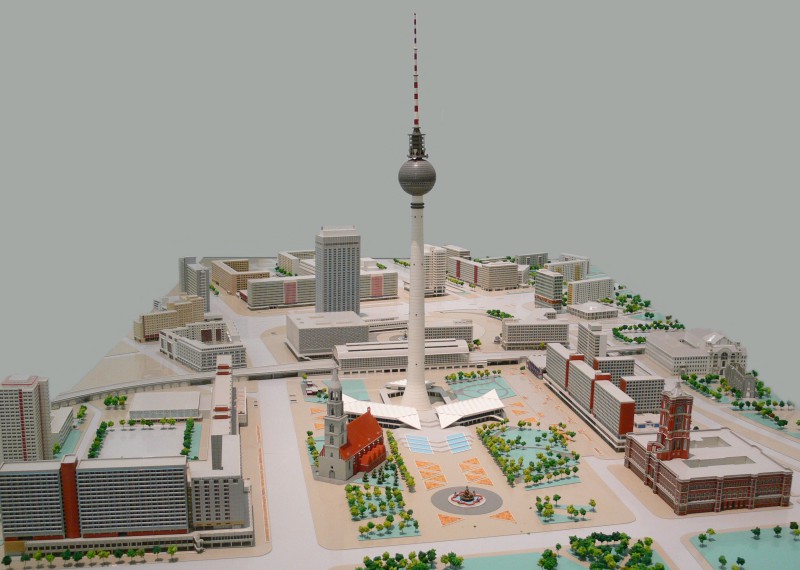 XXX
XXX
Fig.033Berlinische Galerie, Berlin: Stadtmodell aus DDR-Zeiten, Alexanderplatz und Marx-Engels-Forum mit Fernsehturm
By Foto von User:Alter jakob [Public domain], from Wikimedia Commons
 XXX
XXX
Fig.004Stadtzentrum West - Stadtzentrum Ost
Bruno Flierl (Architekturkritiker & Experte für Architektur und Städtebau der DDR)
© Judith Affolter & Thomas Eugster
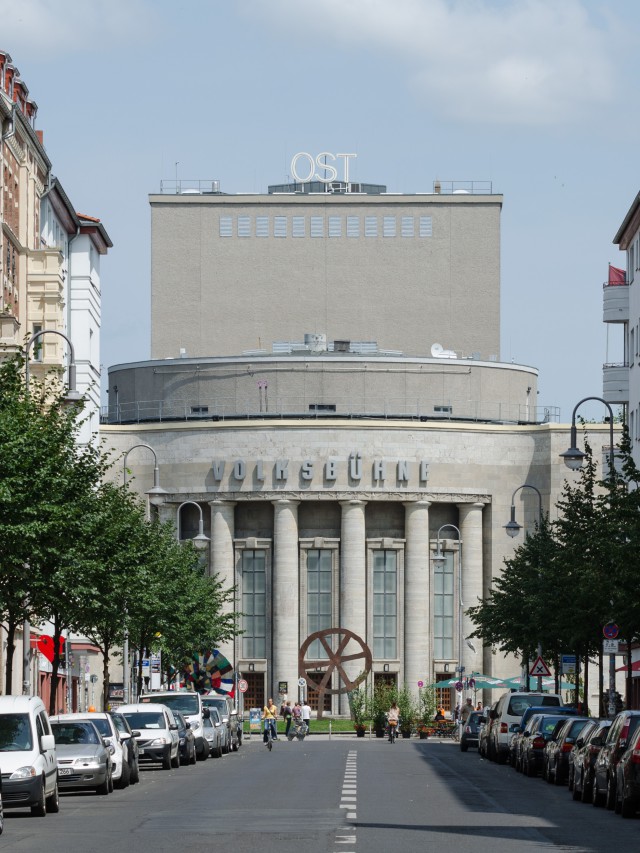 XXX
XXX
Fig.035The Volksbühne in Berlin as seen from Rosa-Luxemburg-Straße, 2013
By DXR [CC BY-SA 3.0 (https://creativecommons.org/licenses/by-sa/3.0)], from Wikimedia Commons
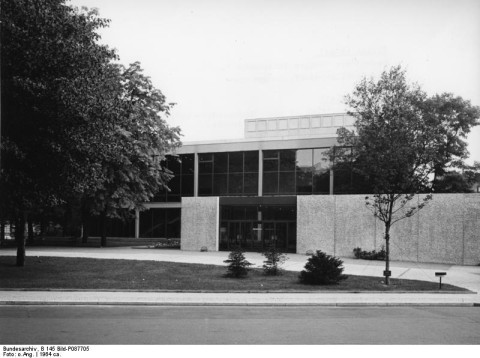 XXX
XXX
Fig.036Freie Volksbühne Berlin 1964
Bundesarchiv, B 145 Bild-P087705 / CC-BY-SA 3.0 [CC BY-SA 3.0 de (https://creativecommons.org/licenses/by-sa/3.0/de/deed.en)]
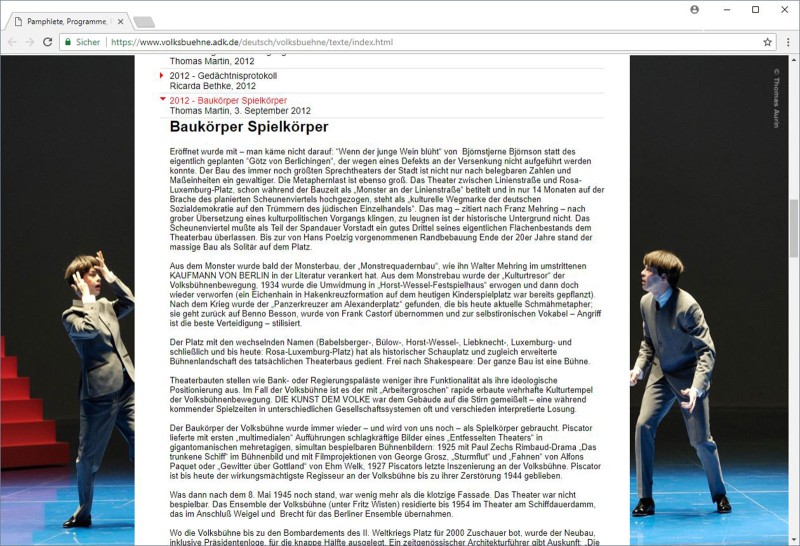 XXX
XXX
Fig.034Volksbühne - Freie Volksbühne
Thomas Martin (Chefdramaturg Volksbühne am Rosa-Luxemburg-Platz)
Dietger Pforte (Vorstandsvorsitzender Freie Volksbühne)
© Volksbühne am Rosa-Luxemburg-Platz
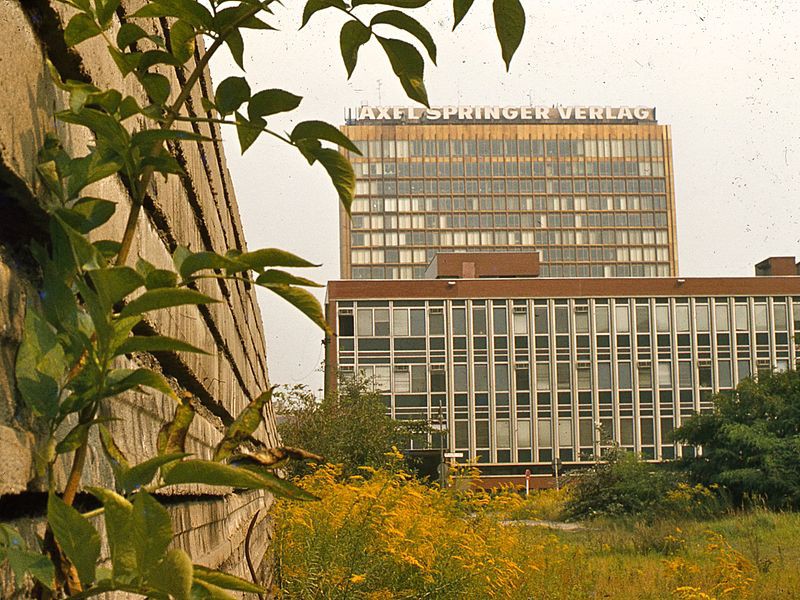 XXX
XXX
Fig.038The Axel Springer Building in Berlin and the Berlin Wall, 1977
George Garrigues [by-sa/3.0]
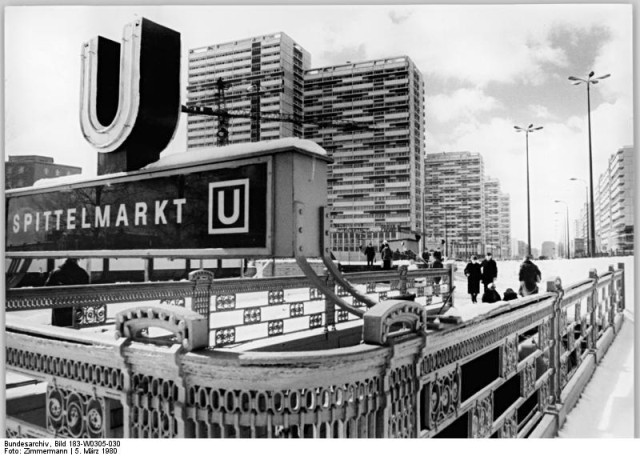 XXX
XXX
Fig.031Leipziger Straße, 1980
Bundesarchiv, Bild 183-W0305-030 / CC-BY-SA 3.0
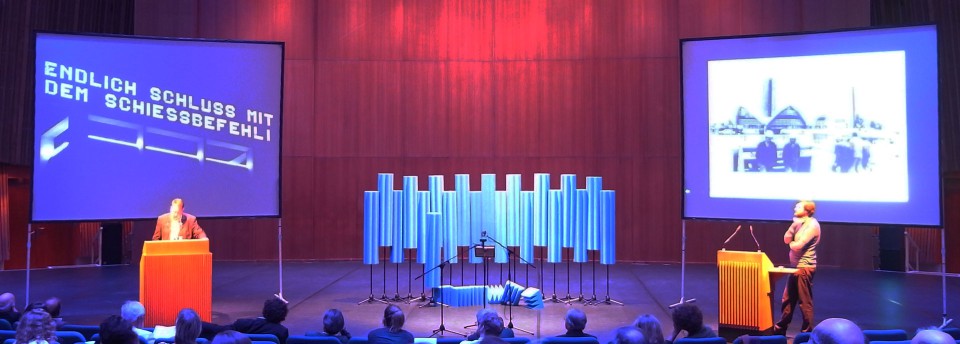 XXX
XXX
Fig.037Axel-Springer-Hochhaus - Komplex Leipziger Strasse
Rainer Laabs (Leiter Unternehmensarchiv Axel-Springer-Verlag)
Tobias Hönig (Initiative Weltkulturerbe Doppeltes Berlin)
© Alexander Koch, KOW Berlin
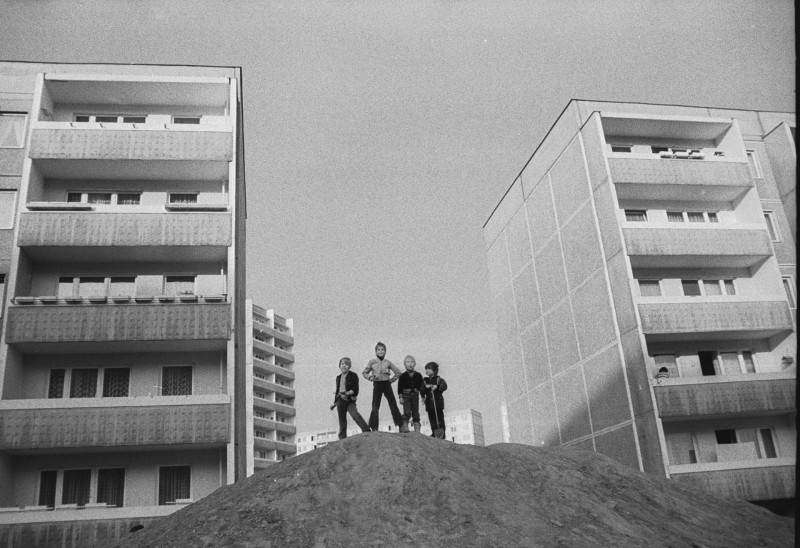 XXX
XXX
Fig.040Marzahn, 1980
Gerd Danigel, ddr-fotograf.de, CC BY-SA 4.0
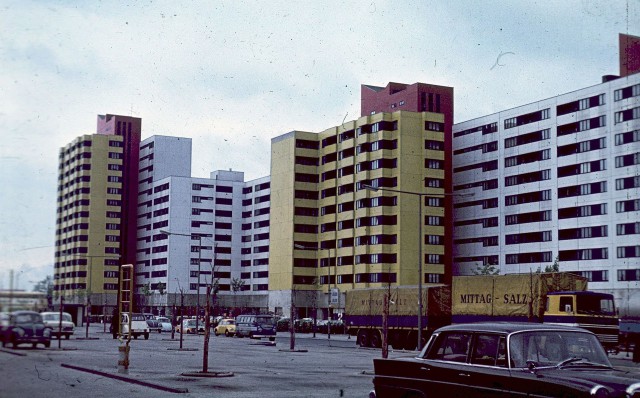 XXX
XXX
Fig.041Märksches Viertel, 1970
Fortepan / G K [CC BY-SA 3.0 (https://creativecommons.org/licenses/by-sa/3.0)], via Wikimedia Commons
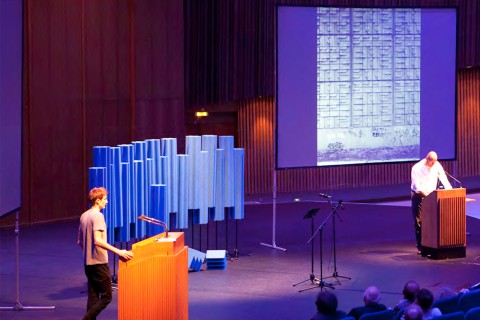 XXX
XXX
Fig.039Großsiedlungen West - Großsiedlungen Ost
Daniel Bruns (Akademie einer neuen Gropiusstadt / Institut für Städtebau und Architektur, TU Berlin)
Gerrit Engel (Architekt und Berliner Stadtfotograf)
© Judith Affolter & Thomas Eugster
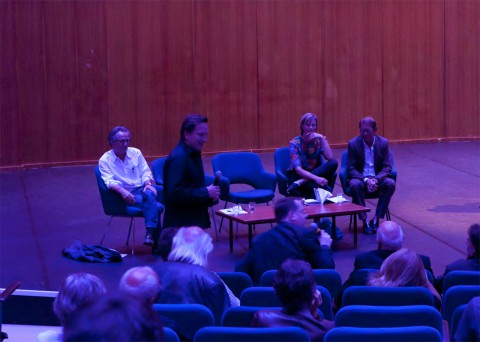 XXX
XXX
Fig.043Open discussion „Weltkulturerbe Doppeltes Berlin?“
Resume
from the perspective of political education: Thomas Krüger
from the perspective of ICOMOS/UNESCO: Jörg Haspel
from the perspective of urban development: Büro Senatsbaudirektorin Regula Lüscher
from the perspective of the Initiative Weltkulturerbe Doppeltes Berlin: Vera Tollmann and Arno Brandlhuber
Moderator: Claudius Seidl (Ressortleiter Feuilleton Frankfurter Allgemeine Sonntagszeitung)
© Judith Affolter & Thomas Eugster
![]() XXX
XXX
Fig.044© Judith Affolter & Thomas Eugster
Initiative Weltkulturerbe Doppeltes Berlin
The close relationship between architecture and ideology is manifested most clearly in ideologically divided territories. The role of architecture as a projection screen for ideological messages is exemplified by East and West Berlin between 1945 and 1989. In both parts of the city highly symbolic state, residential, and cultural buildings were erected and existing buildings were brought into line with ideology.
The results of this ‘architectural arms race’ can be seen to this day in the doubling of buildings in East and West: two congress halls, two Volksbühnen (People’s Theatres) etc. The Initiative World Cultural Heritage Double Berlin regards this mirrored architecture as unique and proposes a public and open research and collection on the doubled architectures of the once divided city of Berlin, to put ‘Double Berlin’ on UNESCO’s world heritage list. In the framework of the exhibition in September, the collective creates a listing of parallel architectures and initiates an official public request. Everyone is invited to take part in the initiative, to contribute material through the initiative office and the corresponding website and propose further parallel architectures.
From the beginning of "Between Walls and Windows" to 11 November 2012, the initiative is setting up its office, along with an exhibition, in the HKW. On Fridays and Saturdays in September, from 4-6 p.m., visitors may personally get in touch with the imitative, inform themselves about its goals and – above all – get involved themselves. The initiative would be delighted to receive pictures from the proposed buildings’ pasts, including materials from private collections: films, documents, newspaper clippings, any kind of memento, even if it is just your own story about the respective building. Your material can be copied straight away in the office so that you can take it home with you immediately. Of course, you are also welcome to digitize the material yourself and send it to us via the website www.doppeltes-berlin.de . Naturally, we will also credit your personal contribution by tagging it with your name.
(PR-statement Haus der Kulturen der Welt)
